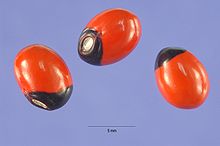Paternoster pea
| Paternoster pea | ||||||||||||
|---|---|---|---|---|---|---|---|---|---|---|---|---|

Paternoster pea ( Abrus precatorius ), illustration |
||||||||||||
| Systematics | ||||||||||||
|
||||||||||||
| Scientific name | ||||||||||||
| Abrus precatorius | ||||||||||||
| L. |
The Paternoster pea ( Abrus precatorius ), also Paternoster bean or crab eyes wine called, is a poisonous plant from the family of legumes (Fabaceae), held today in the entire Tropics is widespread and probably from India comes.
description
This perennial , woody and deciduous tendril reaches heights of growth of up to 6–10 meters. It grows slender and is densely leafy with 5 to 15 cm long, alternately arranged, paired, pinnate, short-stalked leaves, which are composed of many small, elongated to ovate, thin-leather and entire-edged as well as finely-pointed, rounded leaflets . The runny rachis ends in a small bristle and the leaflets are slightly hairy on the underside. Small, often sloping stipules are formed.
The small, short-stalked, white to slightly purple-colored butterfly flowers appear in long-stalked clusters in the leaf axils. They are underlaid by bracts and cover sheets. The clipped, somewhat silky hairy, cup-shaped and greenish, small calyx is only slightly lobed. There are 9 stamens that have grown together with one brother . The ovary is hairy, with a very short style .
It is formed with fine, silky hairy and sometimes blackish, small and pointed, about 2.5–4 cm long, leathery and somewhat puffy legumes with 2–7 seeds. The roundish to ellipsoidal or egg-shaped, smooth and two-colored seeds are 5-8 millimeters in size. The opened fruits stay on the plant for a long time and the seeds then hang out.
The number of chromosomes is 2n = 22.
In Europe, the seeds ( Abri precatorii semen ) are best known. They are hard, smooth and shiny. They are scarlet in color and black in the upper third. They are rarely white or black and white. This is the reason why they owe their name "prayer beads" and their use for rosaries and other prayer chains in Christian and Buddhist cultures. In much of India they are referred to as "rati" and are used to weigh gold because the weight of a seed is roughly one carat (hence the name). The weight of the Koh-i-noor diamond was determined using such seeds. These fruits contain the highly toxic protein abrin . This poison poses a threat, especially due to the increasing spread of natural jewelry made from paternoster peas. The shrub is also used as an ornamental plant.
Taxonomy
It was first described in 1767 by Carl von Linné in Syst. Nat. ed. 12, 2: 472.
Synonyms are Abrus maculatus Noronha , Abrus pauciflorus Desv. , Glycine abrus L. , Orobus americanus Mill. , Zaga latifolia Raf. , Zaga parvifolia Raf.
There are two subspecies:
- Abrus precatorius subsp. precatorius from Asia
- Abrus precatorius subsp. africanus Verdc. from Africa; with slightly smaller, spicy fruits
use
The seeds of the plant are traditionally used in the botanical tribal areas as weights and materials for jewelry. In ancient India they were used as weights (see also Indian weights and measures ). Similar, but larger, are the seeds of Ormosia coccinea , and the red seeds of Adenanthera pavonina have also been used in a similar manner.
Toxicity
All parts of the plant are considered poisonous, but especially the seeds.
Even a single raw pea can be fatal. The seeds contain the highly toxic abrin , a toxalbumin that in its toxic properties of the Ricinus derived ricin is similar and the snake venom has a similar effect. That is why they are also used medicinally.
However, the poison is destroyed by heat, so the seeds are edible when cooked well.
When worn as a jewelry chain on the neck or wrist, it can be assumed that even when sweating, toxic ingredients are not released and therefore there is no risk of poisoning. Ripe seeds that are swallowed whole pass the gastrointestinal tract without releasing toxic abrin and are excreted again. Therefore, swallowing ripe, intact seeds is not expected to cause poisoning.
Ingestion of immature seeds with a still soft (permeable) shell can cause severe poisoning. The paternoster peas contained in jewelry chains have been drilled through for threading. If such chains are chewed or sucked, the abrin contained in the seeds can be released due to the damage to the hard shell and lead to poisoning. In addition, seeds of the paternoster pea can also be found in pepper mixtures, which can be obtained in bazaars in popular travel destinations among German tourists. There, the seeds may have been added incorrectly due to their optical confusion.
literature
- Dongyou Liu: Manual of Security Sensitive Microbes and Toxins. CRC Press, 2014, ISBN 978-1-4665-5396-5 , pp. 443 ff.
Web links
- Paternoster pea on gift Pflanzen.com.
- Abrus precatorius at Pitchandikulam Forest Virtual Herbarium.
- Abrus precatorius at Useful Tropical Plants.
- Abrus precatorius at intox.org.
Individual evidence
- ^ Abrus precatorius at Tropicos.org. In: IPCN Chromosome Reports . Missouri Botanical Garden, St. Louis
- ↑ Federal Institute for Risk Assessment (2012). Jewelry made from paternoster bean seeds is not suitable for children . (Opinion 043/2012, amended on January 21, 2013, p. 3). Berlin: BfR. Retrieved June 6, 2016.
- ↑ Federal Institute for Risk Assessment: Paternoster peas, castor oil & Co. - Exotic souvenirs can contain poisonous plant seeds. July 3, 2019, accessed July 10, 2019 .

